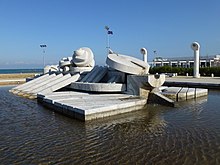-
Gateway of Peace, 1972, Tel Aviv, Israel
-
Nascita, 1973, Middelheim Open Air Sculpture Museum, Antwerp
-
Campo del Sole, various artists, 1985–1989, central sculpture; Tuoro sul Trasimeno, Umbria
-
Il Teatro della Germinazione, Monte Salviano, Abruzzo

Summary
Pietro Cascella (February 2, 1921 – May 18, 2008) was an Italian sculptor. His principal work consisted of large monumental sculptures, including the International Monument to the Victims of Fascism in the Auschwitz II-Birkenau death camp in Poland (1957–1967), and an underground mausoleum for Silvio Berlusconi at his villa in Arcore in the 1980s.[1][2]
Pietro Cascella | |
|---|---|
 | |
| Born | February 2, 1921 Pescara, Italy |
| Died | May 18, 2008 |
| Nationality | Italian |
| Known for | |
| Spouses |
|


Life edit
Cascella was born into a family of artists in Pescara on February 2, 1921. His father was Tommaso Cascella, a painter and ceramicist, and his mother was Susanna Federman.[2] His elder brother Andrea Cascella was a sculptor.[3][4][5][6] Two of his uncles were also artists, the painter Michele Cascella and painter and ceramicist Gioacchino Cascella, as was his grandfather, the painter, ceramicist, and lithographer Basilio Cascella.[2] In 1945 he married Anna Maria Cesarini Sforza, an artist.[1][7][8] From 1977 he lived with his second wife, Cordelia von den Steinen, in the mediaeval Castello della Verrucola in the comune of Fivizzano, above Carrara. He died in Pietrasanta in 2008.[9]
Work edit
In the late 1930s he moved to Rome and studied at the Accademia di Belle Arti under Ferruccio Ferrazzi, who taught both painting and sculpture.[2] He had work in the Quadriennale di Roma painting exhibition of 1943, and in the twenty-fourth Biennale di Venezia in 1948. He also participated in the twenty-eighth Biennale in 1956.[2]
In the years after the Second World War Cascella, with his brother Andrea and various friends, worked in ceramics and mosaic in a brick-works in the Valle dell'Inferno, the brick-making district of Rome. In about 1949 he and his wife Cesarini Sforza were commissioned to create mosaics for the third-class waiting-room of the Stazione Termini, the principal railway station of Rome.[1][4] In 1950, the two completed a large mosaic for a Roman cinema, the Cinema America.[10] At about this time he also made small-scale reliefs in various materials, some of them drawing inspiration from the work of Roberto Matta, who was a friend.[1]
In 1950–1953 some ceramic work was included in the large American exhibition Italy at Work: Her Renaissance in Design Today.[11]: 31
In 1962 his work was included in an exhibition of ceramics at the Galleria dell’Obelisco in Rome. He had a solo show at the Galleria del Milione in Milan in the same year, and another at the Galería Bonino in New York. In the following year, and again in 1972, he had a room at the Biennale. In 1968 his work was shown at the Galèrie du Dragon in Paris and at the Musée d'Ixelles in Brussels. In 1971 Cascella participated in the twenty-third Salon de la Jeune Sculpture in Paris.[12]
In April 2006 he received the Italian Medal of Merit for Culture and Art.[12]
References edit
- ^ a b c d Christopher Masters (June 6, 2008). Pietro Cascella. The Guardian. Accessed June 2021.
- ^ a b c d e Carlo Maria d'Este (2015). Pietro Cascella (1921–2008) (in Italian). Regione Abruzzo: Dipartimento Turismo, Cultura e Paesaggio. Archived 29 June 2021.
- ^ Cascella, Pietro. Benezit Dictionary of Artists. Oxford: Oxford University Press. doi:10.1093/benz/9780199773787.article.B00033204. (subscription required).
- ^ a b Silvia Lucchesi (2003, updated 2009). Cascella, Pietro. Grove Art Online. Oxford: Oxford University Press. doi:10.1093/gao/9781884446054.article.T014558. (subscription required).
- ^ Franco Miracco (1991). Cascella, Pietro (in Italian). Enciclopedia Italiana, appendix IV. Roma: Istituto dell'Enciclopedia Italiana. Accessed June 2021.
- ^ Alexandra Andresen (1991). Cascella, Andrea (in Italian). Enciclopedia Italiana, appendix V. Roma: Istituto dell'Enciclopedia Italiana. Accessed June 2021.
- ^ "Cinema America, Cesarini Sforza: "Quando io e Pietro Cascella realizzammo i mosaici della sala"". la Repubblica (in Italian). June 18, 2014. Retrieved June 25, 2021.
- ^ "La firma di Pietro Cascella e Anna Maria Cesarini Sforza dietro i mosaici del Cinema America - Roma - Repubblica.it". Roma - La Repubblica. June 18, 2014. Retrieved June 25, 2021.
- ^ Cascèlla, Pietro (in Italian). Enciclopedie on line. Roma: Istituto dell'Enciclopedia Italiana. Accessed June 2021.
- ^ ""America", i mosaici di Cascella allontanano l'ipotesi demolizione". Corriere della Sera (in Italian). June 18, 2014. Retrieved June 25, 2021.
- ^ Meyric Reynold Rogers (1950). [https://archive.org/details/italyatworkherr00rogegoog/page/n14/mode/1up Italy at Work: Her Renaissance in Design Today. Published in Italy for the Compagnia Nazionale Artigiana.
- ^ a b Walter Recinella (February 2, 2021) 2 Febbraio 1921: i primi 100 anni di Pietro Cascella (in Italian). Roma: Ente Nazionale Assistenza Sociale ai Cittadini. Archived 12 April 2021.


